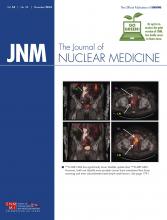Research ArticleClinical Investigations
An SPM8-Based Approach for Attenuation Correction Combining Segmentation and Nonrigid Template Formation: Application to Simultaneous PET/MR Brain Imaging
David Izquierdo-Garcia, Adam E. Hansen, Stefan Förster, Didier Benoit, Sylvia Schachoff, Sebastian Fürst, Kevin T. Chen, Daniel B. Chonde and Ciprian Catana
Journal of Nuclear Medicine November 2014, 55 (11) 1825-1830; DOI: https://doi.org/10.2967/jnumed.113.136341
David Izquierdo-Garcia
1Athinoula A. Martinos Center for Biomedical Imaging, Department of Radiology, Massachusetts General Hospital and Harvard Medical School, Charlestown, Massachusetts
Adam E. Hansen
2Department of Clinical Physiology, Nuclear Medicine, and PET, Rigshospitalet, Copenhagen University Hospital, Copenhagen, Denmark
Stefan Förster
3Department of Nuclear Medicine, Technische Universität München, Munich, Germany
Didier Benoit
2Department of Clinical Physiology, Nuclear Medicine, and PET, Rigshospitalet, Copenhagen University Hospital, Copenhagen, Denmark
Sylvia Schachoff
3Department of Nuclear Medicine, Technische Universität München, Munich, Germany
Sebastian Fürst
3Department of Nuclear Medicine, Technische Universität München, Munich, Germany
Kevin T. Chen
1Athinoula A. Martinos Center for Biomedical Imaging, Department of Radiology, Massachusetts General Hospital and Harvard Medical School, Charlestown, Massachusetts
4Department of Health Sciences and Technology, Massachusetts Institute of Technology, Cambridge, Massachusetts; and
Daniel B. Chonde
1Athinoula A. Martinos Center for Biomedical Imaging, Department of Radiology, Massachusetts General Hospital and Harvard Medical School, Charlestown, Massachusetts
4Department of Health Sciences and Technology, Massachusetts Institute of Technology, Cambridge, Massachusetts; and
5Program in Biophysics, Harvard University, Cambridge, Massachusetts
Ciprian Catana
1Athinoula A. Martinos Center for Biomedical Imaging, Department of Radiology, Massachusetts General Hospital and Harvard Medical School, Charlestown, Massachusetts

Data supplements
Supplemental Data
Files in this Data Supplement:
In this issue
Journal of Nuclear Medicine
Vol. 55, Issue 11
November 1, 2014
An SPM8-Based Approach for Attenuation Correction Combining Segmentation and Nonrigid Template Formation: Application to Simultaneous PET/MR Brain Imaging
David Izquierdo-Garcia, Adam E. Hansen, Stefan Förster, Didier Benoit, Sylvia Schachoff, Sebastian Fürst, Kevin T. Chen, Daniel B. Chonde, Ciprian Catana
Journal of Nuclear Medicine Nov 2014, 55 (11) 1825-1830; DOI: 10.2967/jnumed.113.136341
An SPM8-Based Approach for Attenuation Correction Combining Segmentation and Nonrigid Template Formation: Application to Simultaneous PET/MR Brain Imaging
David Izquierdo-Garcia, Adam E. Hansen, Stefan Förster, Didier Benoit, Sylvia Schachoff, Sebastian Fürst, Kevin T. Chen, Daniel B. Chonde, Ciprian Catana
Journal of Nuclear Medicine Nov 2014, 55 (11) 1825-1830; DOI: 10.2967/jnumed.113.136341
Jump to section
Related Articles
Cited By...
- Simultaneous EEG-PET-MRI identifies temporally coupled, spatially structured hemodynamic and metabolic dynamics across wakefulness and NREM sleep
- Nigrostriatal Dopaminergic Neurotransmission and Resilience to Peripheral Systemic Risk Factors for Gait Slowing upon Transition to Uneven Surfaces in Older Adult
- On the analysis of functional PET (fPET)-FDG: baseline mischaracterization can introduce artifactual metabolic (de)activations
- Generation of synthetic TSPO PET maps from structural MRI images
- Robust deep learning estimation of cortical bone porosity from MR T1-weighted images for individualized transcranial focused ultrasound planning
- Neuroinflammation in post-acute sequelae of COVID-19 (PASC) as assessed by [11C]PBR28 PET correlates with vascular disease measures
- The functional and structural associations of aberrant microglial activity in major depressive disorder
- Multimodal Investigation of Neuroinflammation in Aviremic Patients With HIV on Antiretroviral Therapy and HIV Elite Controllers
- Characterization and Mitigation of Model Bias in Parametric Mapping of Dopamine Response to Behavioral Challenge
- Assessment of Motion Bias on the Detection of Dopamine Response to Challenge
- A Simultaneous [11C]Raclopride Positron Emission Tomography and Functional Magnetic Resonance Imaging Investigation of Striatal Dopamine Binding in Autism
- Epigenetic Signatures of Human Myocardium and Brown Adipose Tissue Revealed with Simultaneous Positron Emission Tomography and Magnetic Resonance of Class I Histone Deacetylases
- Moving Toward Multicenter Therapeutic Trials in Amyotrophic Lateral Sclerosis: Feasibility of Data Pooling Using Different Translocator Protein PET Radioligands
- Imaging of neuroinflammation in migraine with aura: A [11C]PBR28 PET/MRI study
- Synthesis of Patient-Specific Transmission Data for PET Attenuation Correction for PET/MRI Neuroimaging Using a Convolutional Neural Network
- Dixon-VIBE Deep Learning (DIVIDE) Pseudo-CT Synthesis for Pelvis PET/MR Attenuation Correction
- An Efficient Approach to Perform MR-Assisted PET Data Optimization in Simultaneous PET/MR Neuroimaging Studies
- Pseudoreference Regions for Glial Imaging with 11C-PBR28: Investigation in 2 Clinical Cohorts
- PET/MRI in the Presence of Metal Implants: Completion of the Attenuation Map from PET Emission Data
- Dopamine in the medial amygdala network mediates human bonding
- Clinical Evaluation of Zero-Echo-Time Attenuation Correction for Brain 18F-FDG PET/MRI: Comparison with Atlas Attenuation Correction
- Insights into neuroepigenetics through human histone deacetylase PET imaging
- Multi-Atlas-Based Attenuation Correction for Brain 18F-FDG PET Imaging Using a Time-of-Flight PET/MR Scanner: Comparison with Clinical Single-Atlas- and CT-Based Attenuation Correction
- Dixon Sequence with Superimposed Model-Based Bone Compartment Provides Highly Accurate PET/MR Attenuation Correction of the Brain
- MRI-Based Attenuation Correction for PET/MRI Using Multiphase Level-Set Method
- Evaluation of Atlas-Based Attenuation Correction for Integrated PET/MR in Human Brain: Application of a Head Atlas and Comparison to True CT-Based Attenuation Correction
- Fast Patch-Based Pseudo-CT Synthesis from T1-Weighted MR Images for PET/MR Attenuation Correction in Brain Studies
- MR-Based Attenuation Correction Using Ultrashort-Echo-Time Pulse Sequences in Dementia Patients






